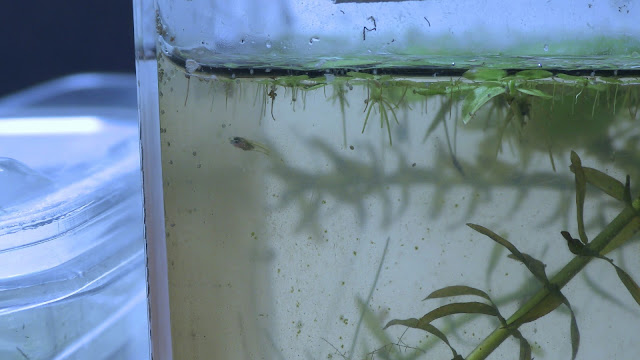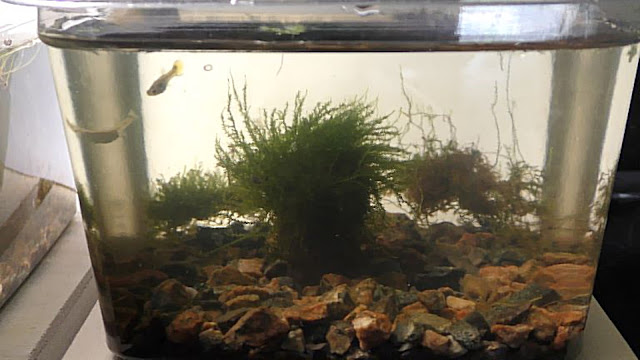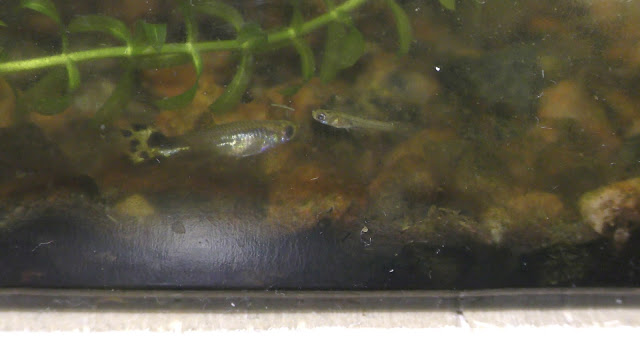Breeding guppies is a very interesting adventure.
The first step is to set up an aquarium with live plants and aquatic critters.
The first step is to set up an aquarium with live plants and aquatic critters.
I prepared 2 aquariums, weeks in advance, as shown in a previous video.
The next step is to get guppies.
It's better to get young guppies, preferably newborn.
Ask for them from someone who breeds guppies.
People like to share!
It's important to know the ages of fish for breeding.
Immature fish is the best for a clean slate!
Transfer your fish to the aquarium you prepared for them.
Pet stores sell adult fish.
Later in this video, you will see how I start with adult guppies.
Here I have 5 day-old guppies, born on March 23rd, 2018
All newborn guppies look like females.
June 13th, 2018
This one is a male.
Usually male guppies mature first.
Check my previous video on guppy gender.
I transfer young males into a separate aquarium as soon as I can identify their gender.
It is necessary to separate all males from females until a desirable male (for breeding) is chosen.
Be aware that prolonged seclusion of a single guppy is harmful for the guppy.
June 15th, 2018
I identified and transferred another male.
Here are the 2 males.
They spend most of the time looking at young females.
Label aquariums indicating fish birthday, generation, gender, etc.
Female guppies will mature in the following months.
Here you can see both males on July 11th, 2018
Variations in color, size, shape and so on, can be passed on through selective breeding leading to a new strain.
I breed a dwarf size strain.
Therefore, I select the smallest fish for breeding.
I put each male with 1-3 females.
Each male with females gets a separate tank.
This large male is with 2 large females.
The small male is with 3 small females.
I don't know yet whether the fish are fertile or not.
A higher number of females per male increases the chances of successful breeding.
Also, males can be infertile too.
Guppies are very adaptive fish.
And yet, guppies, like all other known living organisms, breed only under appropriate breeding conditions.
Check links in the description about feeding and other parts of aquarium fish care routines.
Guppies love homemade fish food.
My guppies breed at a water temperature of 72-76 F.
Guppy males work very hard to get the attention of females, constantly chasing after them and sporting tails at every occasion, performing mating dance.
Guppy females are most attracted to males with predominantly orange or red tails.
Each male carries a rainbow of colors in different amounts (some can be seen only through a magnifying glass).
August 19th, 2018
This female appears to be pregnant.
The pregnancy period is about 1 month long.
It's time to set up an aquarium for newborn guppies.
August 26th, 2018
2 newborn guppies are hiding between plants.
Adult guppies may eat sick or slowly moving fry.
I use a pipette to transfer newborn fry into a new nursery.
1 or 2 babies in the first drop is common for my strain of guppies.
Each following birth yields more babies until it reach the highest number for this stain.
Then the number of newborns per drop declines.
Label the new aquarium.
The average lifespan of guppies is 2-5 years, and they are fertile only for the first couple years.
Larger size fish tend to live longer and yield more babies in each drop.
Guppies give birth every month or so.
Sooner or later it becomes impossible to keep all of them.
I keep only fish chosen for further breeding.
The rest of the fish has to be culled.
I prefer to give them away.
As in this example, I give away a male and 3 females (without babies yet) on September 10th to one of my YouTube friends.
Here they go.
Now I can transfer the young fry into the vacant aquarium, where they are going to grow to full maturity.
In this way, I manage to grow one breeding line in just 3 aquariums.
Also, as you may notice, I use small size aquariums suitable only for small size fish.
I don't use man-made filters, air pumps, or water heaters.
And I don't change water.
It's all explained in different videos (links in the description).
One of the females from the parenting aquarium can be moved now to make more room in this small aquarium for the breeding couple.
In this example, I move the female to a larger aquarium where I keep a different breeding line - mix 2.
At this point I have 5 breeding lines ;)
All my breeding lines originated from one parenting couple.
Males of this line have hot red tails and a thicker body.
Fish grow their entire lives.
I move my fish to larger aquariums as necessary.
Guppies do not breed in aquariums with the narrowest side less than 3 length of the fish size, as I explained it in one of my previous videos.
Here I move the parents into my oldest 1.6 liter aquarium, that was vacant for a while.
I keep the smaller parenting aquarium ready for the next newborns.
November 9th, 2018
Here you can see a newborn baby.

The baby seems to be healthy and moving fast.
I can keep it with its parents.
Though, I prefer to move newborns to a vacant nursery.
Also, there could be more than one fry hiding somewhere.
Sometimes I find newborns a couple days apart.
Here are a couple months old fry.
The larger one is most likely a male.
Males grow faster in the first months.
Okey. Let's move the newborn into a vacant nursery.
Also, I add some seed shrimp from the parenting aquarium to both nurseries.
Guppy fry eat seed shrimp.
Here the baby comes.
November 13th, 2018
I transfer the newborn to the aquarium with older siblings.
Guppies feel better kept in schools.
Here you can see all 3 young.
December 20th, 2018
Here you can see the youngest fry next to the older male sibling.
January 4th, 2019
The parenting couple has 2 newborns.
You can see them in the back.
I move newborns into the vacant nursery.
As guppies grow, I will have to choose which to keep for breeding.
And so it goes.
Breeding guppies with desirable traits takes many generations of fish.
Often making it a lifetime hobby.
Have fun and happy hobby :)



































































































Your videos are very inspiring to me and very helpful. My guppy recently had 20 babies. I moved them to another aquarium but one by one all died. My temperature is usually twenty degrees and I changed 25 percent of the water every two days. Today I noticed newborns again, should I leave them with their parents? Thanks for your good job. I forgot to mention I fed them with guppy flake food grinded with my fingers
ReplyDeleteThere could be many reasons why fish die.
DeleteYou can leave newborn with parents.
I would put newborn in 3-4 of different nurseries and try to do less water changes.
All the best!